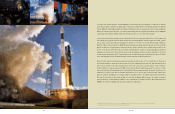Lockheed Martin 2002 Annual Report Download - page 19
Download and view the complete annual report
Please find page 19 of the 2002 Lockheed Martin annual report below. You can navigate through the pages in the report by either clicking on the pages listed below, or by using the keyword search tool below to find specific information within the annual report.
TWENTY-SIX
Lockheed Martin Corporation
MANAGEMENT’SDISCUSSION AND ANALYSIS OF FINANCIAL CONDITION AND RESULTS OF OPERATIONS
December 31, 2002
INDUSTRY CONSIDERATIONS
Defense Business Considerations
In recent years, domestic and worldwide political and eco-
nomic developments have had a significant impact on the mar-
kets for defense and advanced technology systems, products
and services. Markets for defense and advanced technology
systems during 2002 and in the foreseeable future will con-
tinue to be affected by the worldwide war against terrorism
and threats created by the potential widespread availability of
weapons of mass destruction. These realities have increased
the need for greater attention to the security of our homeland
and for better communication and interplay between law
enforcement, civil government agencies and our military serv-
ices. Our nation’s overall defense posture continues to move
toward a more capabilities-based structure, which creates the
ability for a more flexible response with greater force mobil-
ity, stronger space capabilities, better missile defense and
improved information systems security.
The President’s budget for the U.S. Department of
Defense (DoD) for fiscal year 2003 and beyond reflects the
transformation of the country’s national defense posture and
responds to increased needs for homeland security and defeat-
ing terrorism. This is evidenced by budget increases for opera-
tional readiness and personnel needs, as well as for both
procurement and research and development. While there is no
assurance that the increased DoD budget levels will be
approved by Congress, the current defense budget outlook is
one of modest growth. However, the level of growth and the
amount of the budget that will ultimately be allocated to the
investment accounts (i.e., procurement, research and develop-
ment) is unknown.
Our broad mix of programs and capabilities gives us the
ability to support the needs of the various agencies of the
U.S. Government that require our products and services. Our
product areas and programs include: missile defense; space
intelligence; command, control, communications, computers,
intelligence, surveillance and reconnaissance (C4ISR); air
mobility aircraft; and air power projection/precision strike
capability. In terms of size and long-term potential impact,
two of our more important programs are the F/A-22 fighter
aircraft program and the F-35 Joint Strike Fighter program.
We are also represented in almost every aspect of land, sea, air
and space-based missile defense, including the PAC-3 and
THAAD programs. In the areas of space intelligence and
information superiority, we have leadership positions on the
Milstar, Advanced Extremely High Frequency (AEHF) and
Space-Based Infrared System-High (SBIRS-H) programs, and
in battle management command and control capabilities. In
airlift, we have the C-130J program and are under contract to
upgrade the C-5 strategic airlift aircraft. Many of these pro-
grams are large and require funding over several budget
cycles. There are risks associated with these and other large,
highly visible programs that are subject to appropriation by
Congress which, because of their size, could be expected to
become potential targets for reductions or extensions of their
funding to pay for other programs.
In addition, the increase in emphasis on homeland secu-
rity may increase demand for our capabilities in areas such as
air traffic management, biohazard detection systems for postal
equipment, information systems security and other technical
systems solutions. Recent trends have indicated an increase in
demand by federal and civil government agencies for upgrad-
ing and investing in new information technology systems. This
is an area where we have continued to focus our resources.
In prior years, companies in our industry had reacted to
historically shrinking defense budgets for procurement,
research and development by combining to maintain critical
mass and achieve cost savings. More recently, we have
focused our efforts on cost savings and improving efficiency,
as well as generating cash to repay debt incurred during the
period of consolidation. Through our consolidation activities,
we have been able to pass along savings to our customers,
mainly the DoD.
Non-U.S. defense budgets have generally been declining
over the past decade. As a result, consolidation has also been
occurring in the European aerospace industry, resulting in
fewer but larger and more capable competitors, potentially
resulting in an environment where there could be less demand
abroad for products from U.S. companies. This type of envi-
ronment could reduce opportunities for European partnerships
and sales potential for U.S. exports.
Other Business Considerations
As a government contractor, we are subject to U.S.
Government oversight. The Government may ask about and
investigate our business practices and audit our compliance
with applicable rules and regulations. Depending on the
























